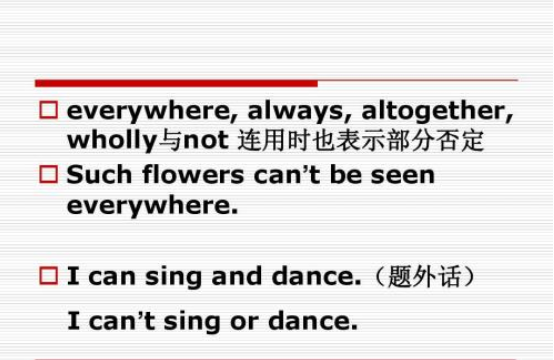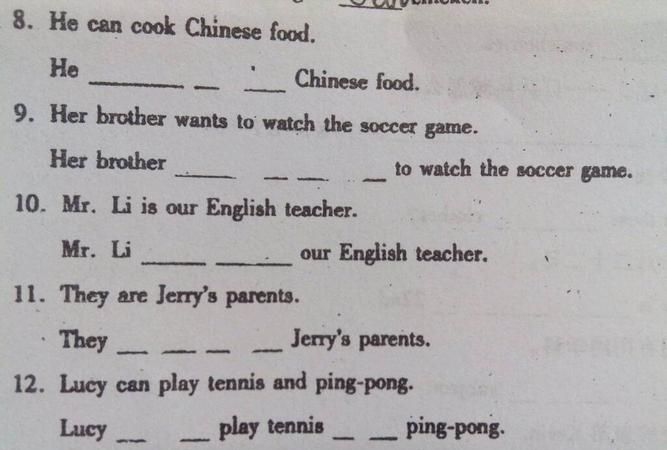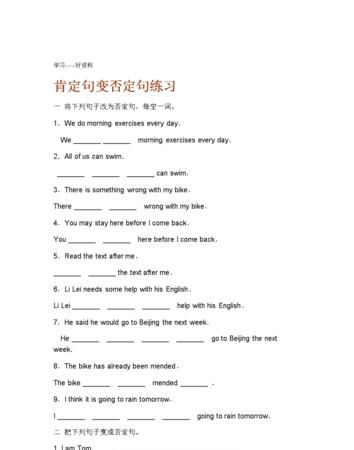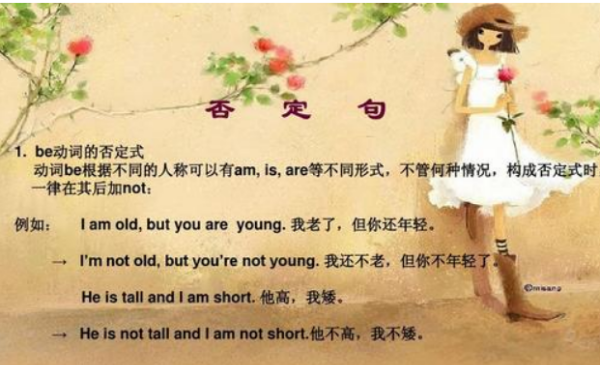本文目录
英语改为否定句怎么改
1、看句中有无be动词,如有,直接在be动词后+ not。
2,看句中有无情态动词如有,直接在情态动词后+ not
3、如上述二者都没有,就应用助动词+ not,分四个步骤:
(1)肯定陈述句中本来是没有助动词的,要加上去,位置在主语(某人或某物)后,动词前。
(2)确定助动词用do、does还是did,根据句中动词,动词是原形的助动词就用do,动词是第三人称单数的助动词就用does,动词用过去式的助动词就有did。
(3)在助动词后加not。
(4)原句中动词假如发生变化就要恢复成原形。

扩展资料:
英语否定结构
1、部分否定:
all, both, every, everybody, everyday, everyone, many, everything,everywhere, always, often等与否定词not搭配使用;表示部分否定。
常常翻译为“并非所有,并不是都”。如:all…not(不全是,不都是),both…not(并非两个都,不是两者都),every…not(不是每个都),not always(不总是,不一定),not often(不经常),not altogether(不全是),not necessarily(未必)等。
2、全部否定:
其否定词为如下:never(决不,从来不),no(没有,不),not(不,不教育学考研辅导是),none(没人,谁都不,没有任何东西),nobody(没人),nothing(什么也没有,没有任何事情)。
we do sports in the morning否定句
回答和翻译如下:
I do not often play sports in the morning.
我在早上不常常做运动。(英语句子翻译,改为否定句翻译)

五年级英语肯定句变否定句的题
1.动词be的否定式
动词be根据不同的人称和时态可以有am,is,are,was,were等不同形式,可用作连系动词(表示“是”、“在”等)和助动词(用于构成进行时态和被动语态等),但不管何种情况,构成否定式时,一律在其后加not:
I’m old,but you’re young.我老了,但你还年轻.
→I’m not old,but you’re not young.我还不老,但你不年轻了.
He was reading and I was writing.他在读,我在写.
→He was not reading and I was not writing.他没有在读,我没有在写.
2.动词have的否定式
动词have根据不同的人称和时态可以有have,has,had等形式,可以用作实意动词和助动词,分以下情况讨论:
1.用作实意动词表示状态,如表示拥有、患病或用于have to表示“必须”等,在构成否定式时可以直接在其后加not,也可根据情况在其前使用don’t,doesn’t,didn’t:
He has a car.他有辆小汽车.
→He hasn’t a car./ He doesn’t have a car.他没有小汽车.
He had some dictionaries.他有一些词典.
→He hadn’t any dictionaries./ He didn’t have any dictionaries.他没有词典.
You have to go with him.你必须同他一起去.
→You haven’t to go with him./ You don’t have to go with him.你不必同他一起去.
【注】have to构成否定式时以在其前加don’t等较为常见.
2.用作实意动词表示动作,如表示“吃(=eat)”、“喝(=drink)”、“拿(=take)”、“收到(=receive)”、“度过(=spend)”等,构成否定式时不能直接在其后加not,而应根据情况在其前使用don’t,doesn’t,didn’t:
He had some cake for breakfast.他早餐吃了些蛋糕.
→He didn’t have any cake for breakfast.他早餐没有吃蛋糕.(不能用had not)
We had a good holiday.我们的假期过得很愉快.
→We didn’t have a good holiday.我们的假期过得不愉快.(不能用had not)
3.用作助动词构成完成时态,其否定式只能在其后加not:
I have read the book.我读这本书.
→I have not read the book.我还没读这本书.
He had left when I arrived.我到达时他已离开了.
→He hadn’t left when I arrived.我到达时他还没有离开.
3、情态动词的否定式
情态动词的否定式一般在其后加not构成:
I can finish the work in an hour.我能在1小时内完成这工作.
→I can’t finish the work in an hour.我不能在1小时内完成这工作.
You must go with us.你必须同我们一起去.
→You mustn’t go with us.你不能同我们一起去.
We should help them.我们应该帮助他们.
→We shouldn’t help them.我们不必帮助他们.
4、实意动词的否定式
一般实意动词的否定式,通常应根据不同时态和人称在实意动词之前加don’t,doesn’t,didn’t等:
He works in a bank.他在一家银行工作.
→He doesn’t work in a bank.他不是在银行工作.
We often hear from her.我们经常收到她的来信.
→We don’t often hear from her.我们不经常收到她的来信.
I met her at the station.我在车站见到了她.
→I didn’t meet her at the station.我在车站没见到她.

怎么改否定句英语口诀
1、看句中有无be动词,如有,直接在be动词后+ not。
即:be动词(am、is、are、was、were)+not、
例: I am a teacher.我是个老师
否定:I am not a teacher.我不是老师。
2、看句中有无情态动词,如有,直接在情态动词后+ not
即:情态动词(can、must、should)+not、
He can help me.他能帮助我。
否定:He can't help me.他不能帮助我。
3、如上述二者都没有,就应用助动词+ not
即:助动词(do、does、did) + not
Put them over there.把他们放那边。
否定:Don't put them over there.不要把他们放那边。

扩展资料
英语中的句子按其语义功能划分为陈述句、(肯定句和否定句)、疑问句(一般疑问句、特殊疑问句、选择疑问句、反义疑问句)、祈使句和感叹句。
1、陈述句:说明一个事实或陈述一种看法。
Light travels faster than sound.(光比声速度快)
The film isn't interesting.(这部电影很乏味)
2、疑问句:
①一般疑问句 Can you finish the work in time?(你能按时完成工作吗?)
②特殊疑问句 where do you live?(你住哪?)
③选择疑问句 Do you want tea or coffee?(你要茶还是要咖啡?)
④反意疑问句 He doesn't know her,does he?(他不认识她,对吗?)
祈使句:提出请求,建议或发出命令,祈使句的肯定句都是以动词原形开头,其否定句都是在动词原形前加don't。
Sit down ,please.(请坐)
Don't be nervous!(别紧张)
以上就是关于五年级上册英语否定句怎么改 ,英语改为否定句怎么改的全部内容,以及五年级上册英语否定句怎么改 的相关内容,希望能够帮到您。

